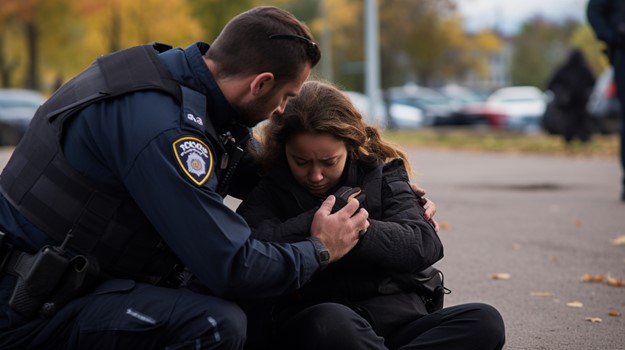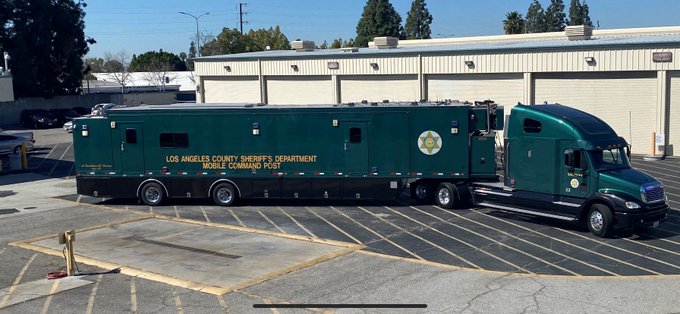
In recent years, the increasing frequency and intensity of natural and man-made disasters have highlighted the essential role of law enforcement agencies in disaster recovery and homeland security efforts. From hurricanes and wildfires to terrorist attacks, the scope and nature of these crises demand a coordinated and well-integrated response from all sectors of emergency management, particularly law enforcement. D’Andre Lampkin, Founder of the Lampkin Foundation, explores the critical role of law enforcement agencies in disaster recovery and homeland security, emphasizing the importance of synergy between law enforcement and disaster recovery professionals to enhance the effectiveness and efficiency of response efforts.
D’Andre Lampkin epitomizes the integration of multidisciplinary expertise in the pursuit of community resilience and disaster recovery. Serving as a Los Angeles County Sheriff’s Deputy and the Vice Chairman of the Los Angeles Region Community Recovery Organization (LARCRO), he harnesses over two decades of experience in disaster recovery, homeland security, law enforcement, healthcare staffing, and civic leadership to drive the organization’s mission forward. Lampkin’s adept coordination of disaster recovery resources and his dedication to strengthening the resilience of those impacted by disasters in the Los Angeles region are central to his role. His vast experience, spanning roles as a healthcare executive, City Planning Commissioner, and Los Angeles County Deputy Sheriff, equips him with a unique perspective on the intersection of public safety, healthcare, and community planning. Lampkin’s leadership not only advances LARCRO’s goals but also exemplifies the critical importance of integrating law enforcement insights and practices into the broader framework of disaster recovery and homeland security, showcasing a model for comprehensive, community-centric response strategies.

The Multifaceted Role of Law Enforcement in Disaster Situations
Law enforcement agencies are among the first responders to any disaster, playing a multifaceted role that extends beyond their traditional duties of crime prevention and investigation. In the context of disaster recovery and homeland security, their responsibilities include securing disaster sites, conducting search and rescue operations, maintaining public order, providing support to affected individuals and communities, and protecting critical infrastructure. D’Andre Lampkin, Founder of the Lampkin Foundation, emphasizes that these tasks require a broad set of skills and a deep understanding of the complexities involved in disaster management.
Securing Disaster Sites
One of the primary roles of law enforcement in the aftermath of a disaster is to secure the affected areas. This involves establishing perimeters around disaster sites to prevent unauthorized access, which could hamper rescue efforts or lead to further casualties. Securing these sites also includes the protection of valuable assets and resources from potential looting or vandalism, ensuring that relief efforts can proceed without interference.
Search and Rescue Operations
Law enforcement officers often work alongside firefighters, medical personnel, and other emergency responders in search and rescue operations. Their training in crisis management and operational coordination makes them invaluable in navigating the chaotic environments that disasters create. Whether it’s through direct participation in rescue efforts or by providing logistical support, law enforcement plays a vital role in saving lives and mitigating the impact of disasters.
Maintaining Public Order
Disasters can lead to situations of panic and confusion, heightening the risk of civil unrest. Law enforcement agencies are crucial in maintaining public order during these times, ensuring that emergency operations can be carried out smoothly and that the rights and safety of individuals are protected. This includes managing evacuations, enforcing curfews, and preventing the spread of misinformation, which can exacerbate the situation.
Support to Affected Communities
Beyond their enforcement duties, law enforcement personnel often provide emotional and logistical support to affected communities. They help in disseminating critical information, assisting in the distribution of aid, and offering reassurance to those impacted by the disaster. Their presence in the community fosters a sense of security and order amidst the chaos, aiding in the psychological recovery of the populace.
Enhancing Synergy between Law Enforcement and Disaster Recovery Professionals
The effectiveness of disaster response and recovery efforts is significantly enhanced by the synergy between law enforcement and other disaster recovery professionals. D’Andre Lampkin, Founder of the Lampkin Foundation, emphasizes this collaborative approach ensures a unified response strategy, leveraging the unique skills and resources of each sector to address the multifaceted challenges of disaster management.
Interagency Coordination and Training
One key to fostering synergy is through regular interagency coordination and joint training exercises. These activities help build mutual understanding and trust among professionals from different fields, allowing for a more seamless integration of efforts during actual disaster situations. Training together enables law enforcement and disaster recovery professionals to familiarize themselves with each other’s operations, techniques, and capabilities, leading to more effective collaboration.
Communication and Information Sharing
Effective communication and information sharing are crucial in coordinating response efforts and making informed decisions. Law enforcement agencies often have access to critical intelligence and information that can aid in disaster recovery efforts, such as data on threats, security risks, and the status of critical infrastructure. By establishing robust communication channels and sharing this information with disaster recovery professionals, they can collectively develop more strategic and effective response plans.
Leveraging Technology for Enhanced Collaboration
Advancements in technology have provided new tools and platforms for enhancing collaboration between law enforcement and disaster recovery professionals. These include integrated communication systems, drones for aerial surveillance and assessment, and software for real-time data analysis and decision support. By leveraging these technologies, both sectors can improve their situational awareness, operational efficiency, and overall effectiveness in managing disaster situations.
D’Andre Lampkin, Founder of the Lampkin Foundation emphasizes that the integration of law enforcement in disaster recovery and homeland security is not just beneficial—it’s essential. The unique capabilities and resources that law enforcement agencies bring to the table complement the efforts of disaster recovery professionals, creating a more resilient and effective response framework. Through continued collaboration, training, and technological innovation, the synergy between these sectors can be further enhanced, ultimately leading to more successful outcomes in the face of disasters. As the challenges posed by natural and man-made disasters continue to evolve, so too must the strategies for managing them, with law enforcement playing a pivotal role in safeguarding our communities and ensuring a swift recovery.



Leave a Reply
You must belogged in to post a comment.